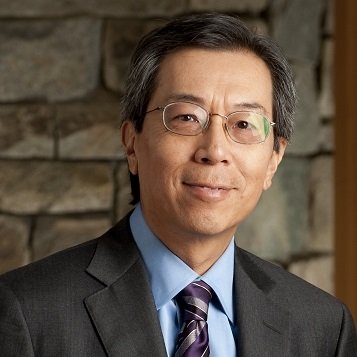 From 2009 until September 2016, Robert Tjian was president of the Howard Hughes Medical Institute (HHMI) — the largest private funder of academic biomedical research in the United States. In 2015, HHMI invested $666 million in biomedical research and provided $85 million in grants and other support for science education. During his time as president, Tjian launched a range of initiatives, including new support for early-career scientists. He remained an active investigator and continued his research on the biochemistry of gene regulation at HHMI’s Janelia Research Campus and at the University of California, Berkeley, where he is a faculty member. After stepping down as head of the institute in September, Tjian returned full-time to his lab at UC Berkeley.
From 2009 until September 2016, Robert Tjian was president of the Howard Hughes Medical Institute (HHMI) — the largest private funder of academic biomedical research in the United States. In 2015, HHMI invested $666 million in biomedical research and provided $85 million in grants and other support for science education. During his time as president, Tjian launched a range of initiatives, including new support for early-career scientists. He remained an active investigator and continued his research on the biochemistry of gene regulation at HHMI’s Janelia Research Campus and at the University of California, Berkeley, where he is a faculty member. After stepping down as head of the institute in September, Tjian returned full-time to his lab at UC Berkeley.
Q: HHMI’s philosophy seems to be to fund smart people, not projects. Do you see any value in the reverse approach — funding a promising project and then identifying the leaders?
A: If you look at the history of the HHMI, we’ve always done both — we put money into structural biology long before that was a well-established field, we put a lot of money into certain aspects of neurobiology and molecular imaging, technology development, and so forth. That’s always been part of our intrinsic strategy. But in all of those cases, we still went after people, not projects. If you see that there’s a major area of interest, let’s say structural biology or particle tracking, you identify really talented people who are likely to have an impact in that field. Some of them may not even come from that field, but you give them the resources to move into it if they wish. I’m absolutely convinced — and that may be my strongest bias — that if I’m controlling a rather large amount of money that I can distribute to support research and discoveries, my best chance at getting the highest return on my investment is in judging the people, not the projects. Because it’s almost impossible to judge a project.
Q: Nowadays there seems to be a big push to work in collaboration, necessitated by the complexity of the questions in the biomedical sciences. Does this change the nature of how science is funded, or should it?
A: I think the funding mechanisms that are out there have always allowed and even fostered both types. I don’t think one should prejudge. Some individuals might work very well as a lone practitioner, and others can be much more effective as teams. The best instances of collaborative research are spontaneous collaborations. I may have funded two or three individuals because of their history of high-quality research, but then they get together and do something completely different. That’s fantastic, as far as I’m concerned. On the other hand, Janelia [Research Campus] is the other way around. We’ve set the whole mechanism up to encourage collaboration because we’re telling people you can’t have a lab that’s more than seven people. You almost have to collaborate. The vast majority of the scientists won’t particularly want to do that, but those who do will take full advantage.
Q: So collaboration could be encouraged, but not imposed, by, for example, grant requirements?
A: I think it’s ok to do that, but the thing that drives science and drives the best scientists is their individual desire, and motivation, and passion. And so having some external entity trying to tell them how to do science seems, to me, counterproductive.
Q: What questions in biology are most exciting today for you personally?

Single particle tracking of wild type Htt protein interacting with an aggregate or inclusion body of mutant Htt by live cell imaging.
A: I’ve been in the field of gene regulation for close to 40 years. I’ve done biochemistry, I’ve done genetics, I’ve done genomics, but the thing that has always eluded us is dynamics and three dimensionality of [molecular] reactions — the real timescale of reactions and macromolecular interactions. It’s been impossible to measure those things when you’re doing measurements almost always as ensemble, looking at millions of molecules, billions of cells, all at the same time, so you’re looking at averages of reactions. The single-molecule reaction one can now finally measure, both in test tubes and in living cells, is a huge breakthrough. That’s kind of the last big piece of the puzzle. Trying to understand how macromolecules bind to DNA or bind to each other, protein-protein interactions — what the kinetics is, what the dynamic nature of the interaction is — that, to me, is the most exciting.
Q: Why is the timescale, in particular, so important?
A: Because we’ve always had this notion that things are a lot more stable. Now we realize that things are happening in seconds, not hours. If you’ve had in the textbooks for decades that a protein binds to DNA and it sits there for minutes, or hours, and you find out that it’s actually 10 seconds, it completely changes the game. Just imagine that for years all you could do was to take still photos — snapshots of everything around you to try to understand how the world works. And then one day, somebody walks in and says, “Hey, I have a molecular movie camera. You can take movies.” Now you can watch things move around in real time and actually see how long something lasts before it moves onto the next step, instead of having to look at a bunch of snapshots. That would change your world, wouldn’t it?
Q: There is a perception among some people in the general public that scientists are constantly changing their mind, and this builds a distrust in the scientific enterprise. Do you think this is a communication problem?
A: There’s a huge disconnect between what the scientists know and what the general public knows. The general public gets very frustrated because it seems like the scientists keep changing their minds, when, in fact, science is built one piece at a time; we don’t have the whole structure. We are changing things constantly because we learn new things and then we have to reevaluate. And somehow that information has to be delivered to the general public.
I think the most important thing is to realize that our general population in the United States has to get more knowledgeable and sophisticated about science, particularly about biology, because people are going to be making decisions every day that impact their own lives without knowing what they’re making a decision about. Whether it’s vaccines or should you be eating red meat or not eating red meat, or should you be taking the PSA test for prostate cancer — if you don’t understand the fundamental process of discovery and science behind a particular recommendation, how can you evaluate whether you should do it or not?
